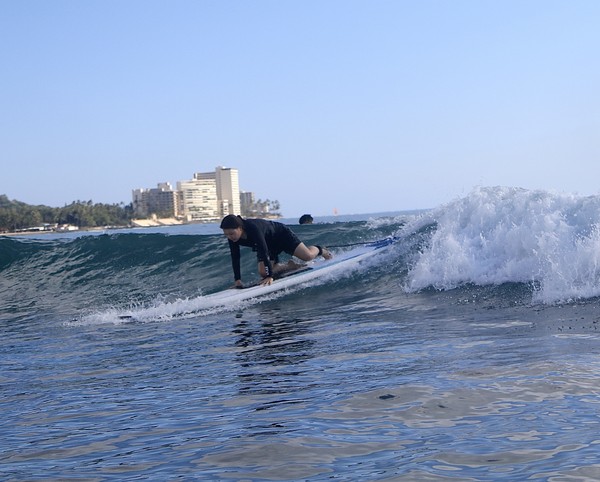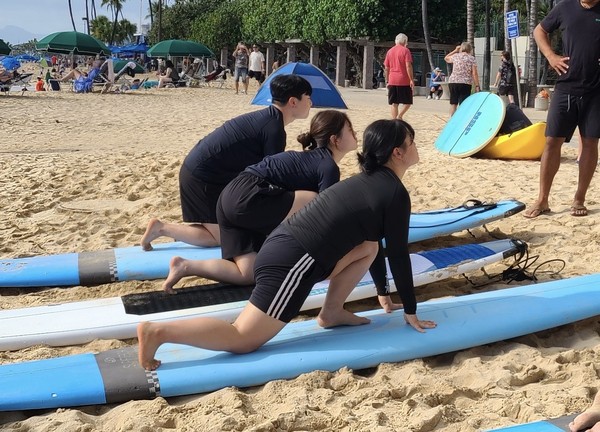
In the hot summer when the sun shines, the sea gives us a cool breeze. The appearance and sound of the waves cools our bodies. Some people feel the ocean waves by dipping our feet in. Others who feel the waves of the sea with their whole bodies. Surfing, a water activity where people ride the waves, is one of the sports that enables people to enjoy the waves of the sea completely. Therefore, this SMT reporter felt the sea through surfing classes in Hawaii, the home of surfing.

Before getting a surfing board
The history of surfing dates to prehistoric times. It originated with people riding the waves using simple tools or their bare bodies. Also, it is recorded that at that time, people regarded surfing as a cultural ritual and used the process of surfing itself as a religious ritual. It means that the act of surfing was a request to the sea-god for protection from the waves. Since then, from the 20th century, surfing started to become a popular sport. An Olympic gold medalist in swimming, Duke Kahanamoku, attempted to open the first surfing club in Hawaii in the 1920s. This was the first step toward the popularization of surfing. As surfing became popular, the first international surfing festival was held in Australia in 1956. After the World Surfing Championships were held in the 1960s and the International Surfing Association was established in 1974, it was clear that surfing had become a global marine sport by them.
Since surfing has a long history, there are various kinds of surfing boards. They vary in size and shape ranging from as much as 9 to 12 ft long to short fish-boards. Since surfing boards have different precautions and difficulties depending on their type, it is important to find the right surfboard for each surfer. Shortboards and fish-boards less than 7 ft can be used even by those of small size, so they can be widely used. However, as it is difficult to balance, they are mainly used by skilled surfers. Fun-boards, which are 7 to 9 ft have high buoyancy and mobility, which make them popular among novice surfers. Dry boards, which are 7 to 12 ft long, are suitable for riding large waves and Long boards, which are 9 to 12 ft have high buoyancy and excellent stability, making them a popular board for both beginners and skilled surfers. All these boards have a pointed shape at the front and a blunt shape at the back. The pointed front part is called the nose, and the blunt back part is called the tail. As the width of the nose widens, it becomes safer, and as the width narrows, stability decreases, but direction change becomes easier. Therefore, it is important to properly adjust the width of the nose. Meanwhile, on the tail at the back, there is a leash, a safety device that connects the body to the board. This leash is a rope that connects the body to the board in case the surfer loses balance and falls into the sea. As such, surfboards vary in size and shape, and the boards are designed so that surfers can enjoy surfing safely.

How to feel the waves
Last winter, this SMT reporter took a surfing class in Hawaii with her family. When starting the class, the instructor said, "Safety is most important." The reason why he emphasized safety is that beginners are more likely to get hurt easily, and it is difficult to stand up on the water. So, warming up by stretching before entering the water is needed. After that, they taught stance and movement, such as balance and paddling. Among them, paddling is an essential technique to ride a wave. After learning to paddle, balancing on the waves is the next step. To ride the board, it is essential to center both legs. First, extend the right leg forward, bend it in the form of 'ㄱ,' and put the left leg straight back. After that, the legs pulled back are also balanced by forming them in the form of 'ㄴ.' The important thing here is to align the two legs with the white line at the center of the board. With the legs bent back and forth like that, put the left foot on the board. Keep one's posture and look forward, and move the left leg supported by the knees to place the feet on the board. When both feet are on the board, just turn them sideways. When the feet are turned sideways along the centerline, the body can rotate and balance on the board at the same time.
After this class at the beach, this SMT reporter went to the sea and surfed, tying the leash that connects the body to the board. To find the soft parts of the waves, a lot of paddling is needed. When a point was reached where people looked like tiny dots, it was time to wait for the waves. The waves should not be too rough or too small, so this reporter waited for the right waves to form. As she was too inexperienced to evaluate the waves, the instructor pushed her board in the direction of the waves when the right ones came. When the right waves came, this reporter maximized the power to move forward pushed by the instructor through paddling. This is because the board has to move quickly to buy time to stand up on the board. Through that process, standing on the board became possible, but balancing on the board was very difficult. At first, this reporter was scared to fall into the water continuously and wanted to give up because it was hard to balance. Even before bending the left knee, her center was unbalanced, and sometimes, she fell right after putting her foot up. After many such attempts, when this reporter eventually stood up and centered herself on the board, she felt pleasure. Although it lasted for only about three seconds, the feeling of standing on the sea was inexplicably thrilling. The moment when this SMT reporter felt the wind of the sea with her whole body was an unforgettable moment in her life.

Feel the wind waves!
The wind is always there for us. The wind can be strong or only slightly, and the experience of feeling it varies depending on the temperature. The wind of the sea makes waves. Without wind, waves cannot be made, and surfers cannot surf without waves. Surfers use this wind to enjoy the waves, So they wait and wait until the right wind blows. After waiting, they finally feel the wind all over their bodies. For this reason, to feel the wind truly, this SMT reporter recommends trying surfing. How about feeling the waves of the wind while surfing this coming summer?



